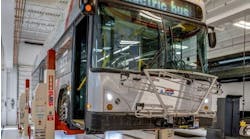Conquer Delays with Intelligent Disruption Management
Transit system operators know from experience that service disruptions are inevitable, and legacy systems operators in particular know this very well. What starts as a minor disruption can have major consequences as the effects trickle down, causing complications to arise rapidly. Anyone relying on public transit in New York City this summer is most likely familiar with what Gov. Andrew Cuomo called the “Summer of Hell,” referring to the period between July and September when travelers were faced with disruptions from emergency repairs at Penn Station and even a track fire. Disruptions wreak havoc on timetables and therefore passengers for the rest of the day- or beyond!
Adapt Your Plan
Depending on the severity of the disruption, you may need to bring in other resources. Instead of leaving this decision solely to your planning team, you can provide them the information they need to find the best resolution with a robust planning system.
One legacy railroad operator felt this impact when overgrown vegetation around its tracks caused a dead tree to fall, knocking out an electrical line and blocking the surrounding track. The disruptive impact was widespread and caused changes in scheduling and a temporary stop in service on certain lines. A maintenance crew was redirected to the site of the incident to dismantle and remove the tree. Electrical service was affected not only on the line that was hit, but also on a connecting line. The railroad’s electrical linemen were brought in to fix the line and restore service. The physical aspects of the disruptions were cleared completely in about 3 hours but service was affected for the rest of the day.
There might have been maintenance crews nearby that could have been called in, but in this particular situation, the transit system might have been better served by a crew that was further away. A different crew with a specific skillset could have been a better choice because they could solve the problem faster and more efficiently. An intelligent planning solution can make recommendations because it has detailed data about what resources are available at the given time and evaluates tradeoffs quickly.
When disruptions occur, an intelligent planning tool automatically takes into account the new circumstances and recalculates. Older systems may have stored historical information but lack advanced analytics required for real-time recalculations.
Adapting a timetable, even with the best plan of action, could potentially require many levels of approval before it can become official and public. Using an automated planning tool quickly gives supervisors a look at the best potential options for moving forward and lets them see the likely repercussions of each change.
After you have explored your options and received approval for the changes you will make based on your current circumstance, you’ll need to update your timetables while minimizing the negative impacts. Do your planners or dispatchers have to scramble through multiple systems to understand the next steps in the plan?
Communicate
Once you’ve used your planning tool to evaluate the best way to manage the inevitable disruption and adapted your timetable to accommodate the new plan, you will need to make sure all decisions have been communicated swiftly and appropriately. You may be able to use disparate tools to adapt your plans but they are not likely to also be able to provide real-time updates to dispatchers and ultimately passengers as well. Using multiple systems pieced together, as many transit agencies do, can cause communication delays when information needs to be entered manually from one system to the next. Not only does this hold up communication, it can also result in many other errors along the way.
When you have the right planning tool in place, your accurate real-time updates can be shared promptly and directly to passengers via digital signage and mobile apps. Customer expectations are high and when dealing with disruptions to their own schedules, they want to know exactly what is happening with their transportation and what to expect next.
Feedback Actual Data to Improve the Planning Process
One key to minimizing the effects of disruption is having good planning data and visibility based on historical information. A powerful planning tool can predict the ramifications of a specific scenario and also provide strategic decision support to help you move forward. Planning tools drive even more value when actual data is analyzed and fed back into the process to further refine planning decisions.
This ability to gather, store, and then take action based on historical information is essential. Using a planning system to analyze characteristics and attributes of disruptions determines what happened, and most importantly, why it happened. This information allows you to more accurately prepare for, if not prevent, future disruptions. For example, perhaps the data analytics show that you need more reserve crews at certain stations after a sporting event, but this effect is lessened if the weather forecast is bad. At times where things generally run more smoothly, you would be able to plan for a smaller reserve crew. Your crew planning has become more efficient. Precise and intelligent data analytics are a vital feedback mechanism to improving the planning process in the next cycles.
Even the best planning tools cannot completely prevent disruptions and delays on their own, but they do empower you to increase your responsiveness and improve the punctuality, reliability, and efficiency of your operations and ultimately maintain passenger satisfaction.
Pete Nelson is a solutions architect with Quintiq.

Pete Nelson | Solutions Architect
Pete has helped hundreds of clients in the last 20 years purchase and implement planning & scheduling systems to improve processes and outcomes in their organizations. As a Solutions Architect for Quintiq, Pete helps clients focus on areas in resource planning where improvements will be most effective, and clarifies the steps necessary to achieve great results. Pete strives to be a thought leader in resolving difficult planning puzzles.




